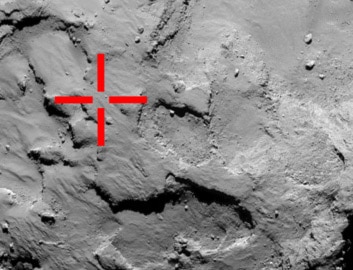Create a free profile to get unlimited access to exclusive videos, sweepstakes, and more!
Rosetta Spots Site of Philae’s First Bounce

Update (Nov. 14, 2014 at 23:00 UTC): Contact with Philae has been re-established! Data taken from the surface (including drill samples) have been sent back to Earth. Not only that, a command was sent to rotate the lander, and that worked as well! It rotated by 35°, enough to point a bigger solar panel up to the Sun. Reports indicate power is flowing, so the life of the mission has at the very least been extended somewhat. This is incredible work by the ESA team!
Update 2 (Nov. 15, 2014 at 00:00 UTC): While the move to rotate the lander was successful, the drain on the battery by the instruments on board was too much. At about half past midnight the voltage dropped below the critical point and the lander put itself into standby mode (no science being done; just communication with the Rosetta orbiter). HOWEVER, the point of the rotation was to get more power available. It's entirely possible that over the next few days, as the comet rotates around, enough sunlight will hit the solar panel to the battery enough charge to restart Philae. As usual, Emily Lakdawalla has more info on this. So Philae is not necessarily dead. It may just be sleeping, hibernating. We could very well hear from it again.
The European Space Agency just released a great short video showing Rosetta's view on the comet where the Philae lander took its first kilometer-high bounce! [Note: If the video is blank, let it run to the end (it's only 12 sconds long), then hit the "replay" button in the video window. It should play normally then. Sorry about that. We're looking into the problem.]
If I've measured this correctly, the red circle is roughly 15 meters (50 feet) across. The "flight dynamics solution" is where the spot was predicted to be given Philae's trajectory, and as you can see they pretty much nailed it.
It's hard to interpret exactly what we're seeing in the before and after. The dark streak looks like a plume of material, but I'm not so sure. Just above and to the right you can see another similar dark feature, and I'm leaning toward them both being shadows cast by low ridges as the angle to the Sun changed between the first image and the second.
These images should prove useful in figuring out just where Philae is; its location is still unknown. As I write this we're still awaiting word that contact between the still-orbiting Rosetta and the lander has been re-established, and the data taken uploaded. Hopefully, samples of the comet have been analyzed by Philae, and we'll get a sense of what materials are on and just below its surface.
This is still very exciting! Certainly, it would've been far better had the lander stayed upright, and able to draw energy from the Sun, but even if that's not to be, it's still done an amazing job.


























